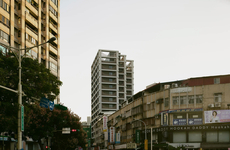
Paperfarm Designs the Contemporary Veil House in Taiwan
Amy Duong — July 31, 2023 — Art & Design
References: paperfarmer & dezeen
Architecture studio Paperfarm designs the new Veil House located in Taiwan. The home is defined by its perforated facade, which opens up natural lighting and airflow whilst maintaining privacy as well. It is meant to reference the area and its history which is rooted in brick manufacturing. The Veil House is built in an urban area in the Kaohsiung neighborhood and has a tall structure with a narrow build.
Partner at Paperfarm Jarrett Boor tells Dezeen that "On narrow streets like the site of Veil House, traditional houses have a large issue with privacy and security, resulting in windows equipped with translucent glass and many with metal security bars. Our approach with Veil House is a reaction to such privacy concerns. However, maintaining the functionality of outdoor spaces where transparency benefitted living conditions was of utmost importance."
Image Credit: Paperfarm
Partner at Paperfarm Jarrett Boor tells Dezeen that "On narrow streets like the site of Veil House, traditional houses have a large issue with privacy and security, resulting in windows equipped with translucent glass and many with metal security bars. Our approach with Veil House is a reaction to such privacy concerns. However, maintaining the functionality of outdoor spaces where transparency benefitted living conditions was of utmost importance."
Image Credit: Paperfarm
Trend Themes
1. Perforated Facades - Innovative architecture designs are using perforated facades to enhance natural lighting and airflow while preserving privacy.
2. Urban Homes - Contemporary urban homes are being built with narrow structures to maximize limited space in densely populated areas.
3. Referencing Local History - Architects are incorporating elements of the area's history into their designs, such as referencing brick manufacturing in the case of the Veil House in Taiwan.
Industry Implications
1. Architecture - The architecture industry can explore new design possibilities by utilizing perforated facades to create sustainable and efficient buildings.
2. Construction - The construction industry can embrace the concept of narrow urban homes to optimize land usage in urban areas with limited space.
3. Historical Preservation - The historical preservation industry can collaborate with architects to incorporate elements of local history into modern designs, creating a bridge between the past and the present.
2.5
Score
Popularity
Activity
Freshness























